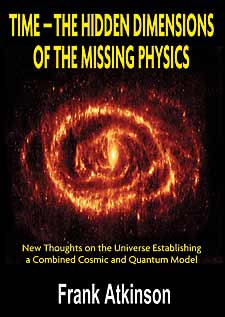Atkinson's Tempo Field Theory - Chapter Summaries
Foreword - Available on this web site
Introduction - Available on this web site
Part I - Developing the Model
The first eight chapters of the book grow naturally, as a model, out of the initial corrective idea. Each chapter identifies the flaws in the current thinking on a particular topic and then proffers a solution supported by the necessary proofs. Because each chapter is progressively developed with proofs there are no leaps of faith required by the reader.
Chapter 1
The Initial Errors
An examination of the scientific facts that were extant at the beginning of the twentieth century, and how they misled Einstein over the speed of light and the measurement of distance.
Chapter 2
The Relative Speed of Light
As a result of the findings in Chapter 1 on the invariability of the measurement of distance proofs on the variability of the speed of light can be given. This leads on to the invariability of mass, and the explanation of inertia.
Chapter 3
Speeds Greater than the Speed of Light on Earth
The requirement of special relativity that objects cannot travel faster than 300,000 kilometres a second, the speed of light on Earth, is set aside and the proofs are illustrated by thought experiments.
Chapter 4
Angular Velocity and Gravity
The flaws in Einstein’s postulates on the foreshortening of distance in the line of travel of an object is analysed by the use of rotational motion. In so doing three different proofs are revealed.
Chapter 5
The Significance of the Blue and Redshift
The author discusses five flaws in Einsteinian relativity relating to the red and blueshift of light. The corrections are given in each case, and we have the first hint of the formation of the Tempo field theory and quantum gravity.
Chapter 6
The Cause of Blue and Redshift
Proofs are given by way of thought experiments to show that the redshift of light does not take place at the surface of a star. It is shown to be the result of the light having to negotiate a time differential between the star and the observer.
Chapter 7
Acceleration and the Principal of Equivalence Revised
Einstein’s famous thought experiment of a man accelerating in a sealed box in space is examined. While the result was in most respects right the explanation was found to be fundamentally flawed. By using the new concept, it is demonstrated that the principle of equivalence is a far more useful tool than had been previously envisaged. It confirms the variability of gravity and the speed of light. It also indicates the way forward for the Tempo field theory, quantum gravity and inertia.
Chapter 8
Time and Quantum Gravity
The author’s views on what time is, and its function, are put forward here and the Tempo field theory is developed. The defining of these ideas gives rise, in a logical progression to a theory of quantum gravity. It becomes apparent that time is the agent of gravity and not, as commonly held, that gravity is the agent that warps time. It is clearly reasoned that Einstein’s metric theory of gravity is not required, a far simpler explanation being proffered in its stead.

